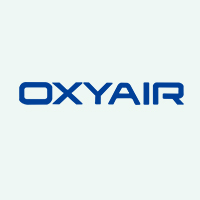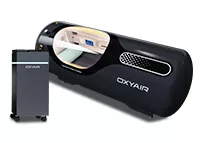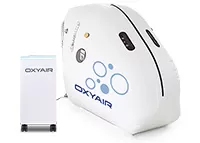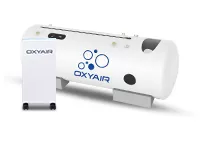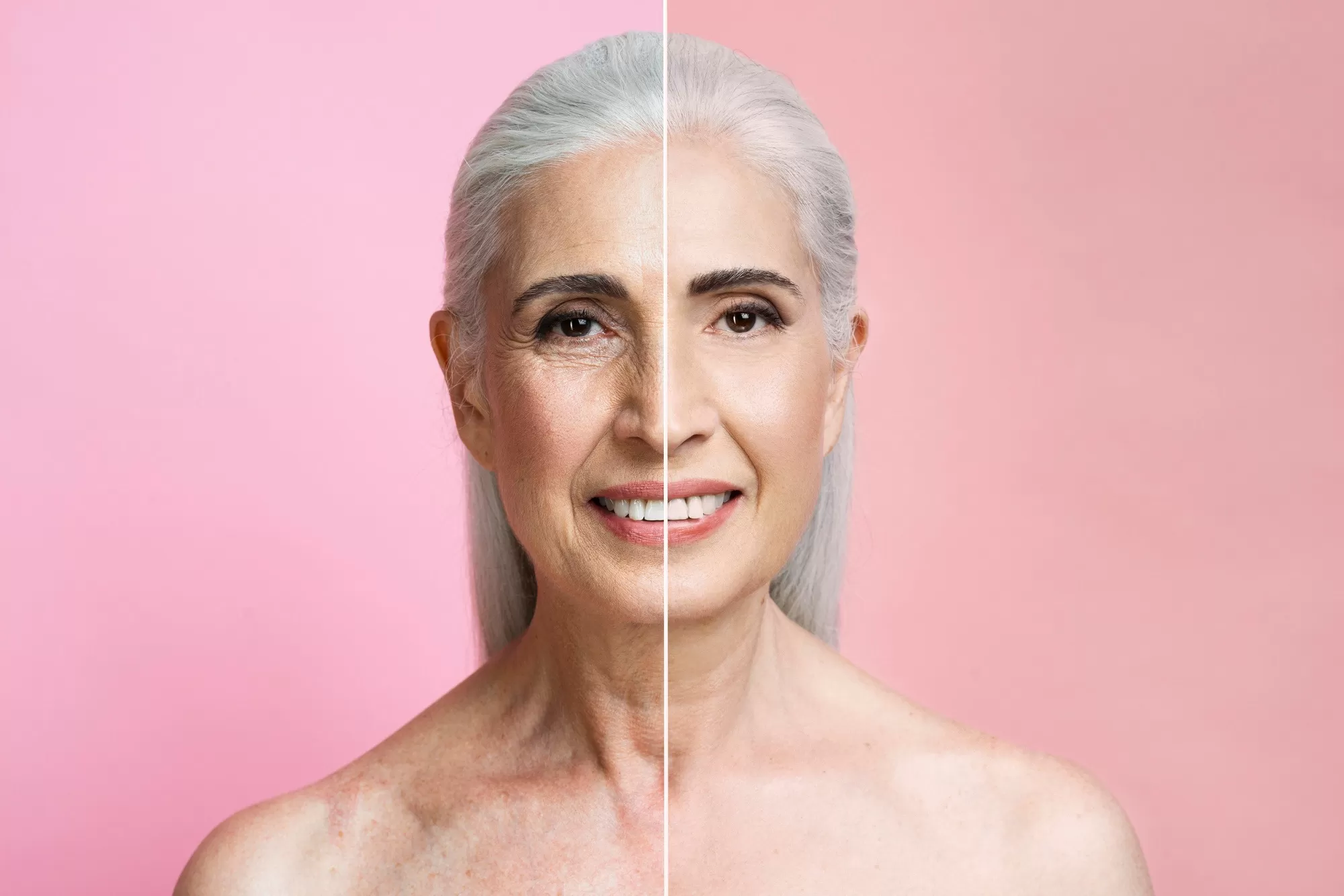Can hyperbaric chamber prolong life
Do Hyperbaric Chambers Extend Life? --Silicon Valley Billionaire's “Life Extension” Experiment Reveals the Truth
Forbes revealed that Jeff Bezos invested $120 million to establish Aan). Meanwhile, more radical Silicon Valley biohacker Bryan Johnson has publicly shared his daily HBOT data as part of his Blueprint program. After a six-month course of treatment, his biological age was reversed by 5.1 years (measured through DNA methylation testing).
Behind this “oxygen-for-longevity” trend lies the commercial reality of a 173% surge in the global hyperbaric oxygen chamber market in 2022. But are these million-dollar oxygen therapy plans embraced by the ultra-wealthy truly technological breakthroughs—or just a new kind of IQ tax?
Principles of Hyperbaric Oxygen Chamber Explained
What is HBOT Therapy? (Hyperbaric Oxygen Therapy)
HBOT (Hyperbaric Oxygen Therapy) is a medical technique that treats diseases or promotes recovery by having patients inhale pure oxygen in a high-pressure environment. The core principle involves placing the patient in a sealed chamber where they breathe 100% oxygen at pressures ranging from 1.3 to 3 atmospheres absolute (ATA), significantly higher than the normal atmospheric pressure (1 ATA).
Under normal conditions, we breathe air containing about 21% oxygen, which enters the lungs and binds to hemoglobin in red blood cells for transport throughout the body. In a hyperbaric environment, however, the amount of oxygen dissolved directly into the plasma increases dramatically. This means that, in addition to red blood cells carrying oxygen, the plasma can deliver large amounts of oxygen to body tissues. As a result, HBOT boosts tissue oxygenation, promotes the growth of new blood vessels, accelerates the repair of damaged tissues, and inhibits the growth of anaerobic bacteria.
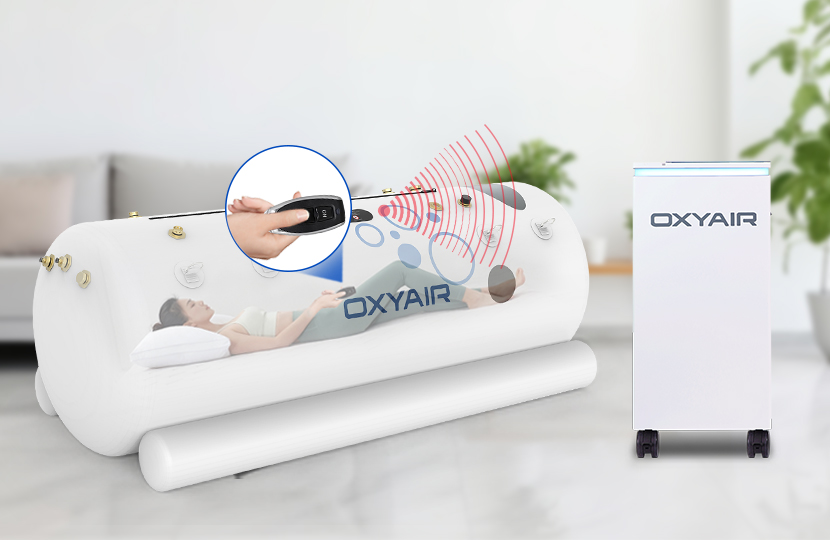
What does 2.0 ATA Hyperbaric Chamber stand for? Why was this standard chosen?
ATA (Atmospheres Absolute) is the key unit for measuring pressure inside a hyperbaric oxygen chamber. One ATA is equivalent to the standard atmospheric pressure at sea level (approximately 101.3 kilopascals). A pressure of 2.0 ATA means the chamber's pressure is twice that of normal atmospheric pressure—comparable to the pressure experienced when diving 10 meters underwater. Under these conditions, the amount of dissolved oxygen in the blood can increase by 10 to 15 times compared to normal pressure, allowing oxygen to penetrate hypoxic tissues more effectively.
Mechanism Comparison:
-1.3 ATA (Home-use Chambers): Increases blood oxygen levels by about 30%, but is insufficient to trigger stem cell proliferation.
- 2.0 ATA (Medical-grade Chambers): Combines mechanical pressure with high oxygen levels to activate the Nrf2 antioxidant pathway.
Safety Threshold:
Studies show that at pressures above 2.5 ATA, the risk of oxygen toxicity (such as lung injury or seizures) increases significantly. However, at 2.0 ATA for a 90-minute session, the rate of side effects is less than 0.3%.
Tissue Repair Efficiency:
At 2.0 ATA, fibroblast migration speeds up by 40% (important for wound healing), and the secretion of brain-derived neurotrophic factor (BDNF) is enhanced, supporting improved cognitive function.
The relationship between aging and oxygen
The Biological Impact of Oxygen Levels on Aging
When it comes to aging, the relationship between hypoxia (low oxygen) and hyperoxia (high oxygen) is not a simple binary opposition—especially in the context of oxidative stress and antioxidant defenses. Significant deviations from normoxic levels (either increases or decreases in oxygen concentration) often lead to elevated oxidative stress and shortened lifespan. In contrast, moderate adjustments in oxygen levels—whether an increase or decrease—can enhance the body’s antioxidant defenses and slow down the aging process.
These findings suggest that, in the biological impact of oxygen on aging, hypoxia carries a warning threshold, while hyperoxia has a toxicity threshold.
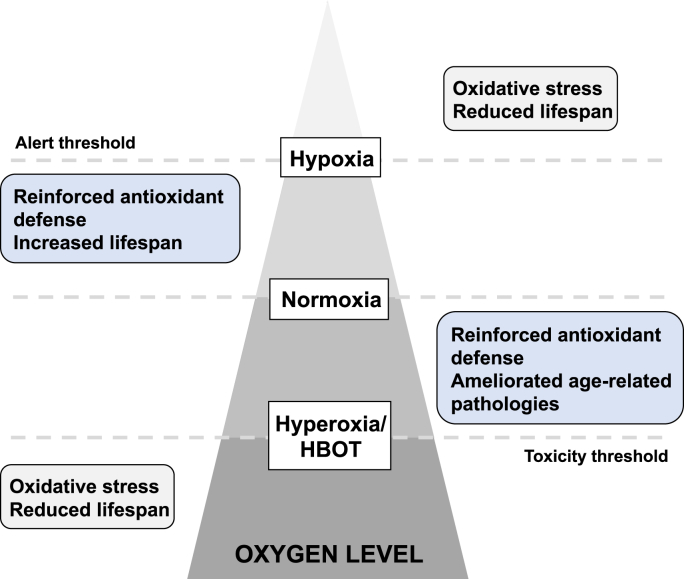
Image courtesy of: Fu, Q., Duan, R., Sun, Y., & Li, Q. (2022). Hyperbaric oxygen therapy for healthy aging: From mechanisms to therapeutics. Redox biology, 53, 102352.
How Hyperbaric Oxygen ‘Reverses Aging and Extends Lifespan’?
In the paper “Hyperbaric Oxygen Therapy for Healthy Aging: From Mechanisms to Therapeutics” published in Redox Biology, the authors outline the biological mechanisms by which hyperbaric oxygen therapy (HBOT) promotes healthy aging. HBOT induces a wide range of cellular, biochemical, and physiological changes. The currently confirmed mechanisms can be summarized into five key categories:
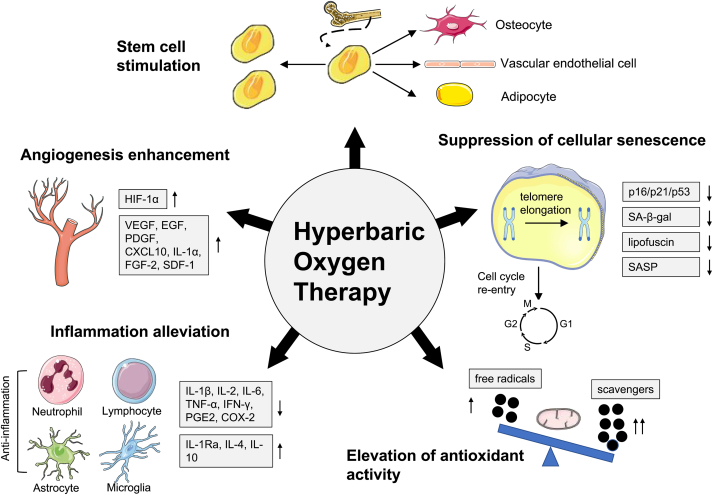
Image courtesy of: Fu, Q., Duan, R., Sun, Y., & Li, Q. (2022). Hyperbaric oxygen therapy for healthy aging: From mechanisms to therapeutics. Redox biology, 53, 102352.
1. Angiogenesis Enhancement:
HBOT enhances angiogenesis primarily by increasing the expression of HIF-1α (Hypoxia-Inducible Factor 1-alpha) and a series of angiogenic markers, promoting the formation of new blood vessels.
2. Inflammation Reduction:
HBOT alleviates inflammation by regulating the number and activity of various inflammatory cell types, including neutrophils, lymphocytes, astrocytes, and microglia. On the molecular level, it suppresses pro-inflammatory factors while boosting anti-inflammatory ones.
3. Antioxidant Defense Enhancement:
By modulating the balance between free radicals and scavengers, HBOT strengthens the body’s antioxidant defenses—a process closely tied to improved mitochondrial function.
4. Senescence Attenuation:
HBOT counteracts the harmful effects of cellular senescence, as shown by the re-entry of cells into the cell cycle and reduced expression of senescence markers such as p16, p21, p53, SA-β-galactosidase, lipofuscin, and SASP (senescence-associated secretory phenotype). It also helps inhibit telomere shortening, a key trigger of cellular aging.
5. Stem Cell Mobilization:
HBOT increases the number of circulating stem cells by stimulating their mobilization and alters their properties by promoting proliferation and differentiation.
Celebrities and Athletes Using HBOT: Why They Trust Hyperbaric Oxygen Therapy
LeBron James: The NBA star invests around $1.5 million annually in physical recovery, which includes using hyperbaric oxygen therapy (HBOT). James uses HBOT to accelerate muscle recovery, reduce inflammation, and improve endurance, helping him maintain peak performance during high-intensity games.
Justin Bieber: The pop singer has openly discussed his use of hyperbaric oxygen chambers as part of his overall health regimen. He uses HBOT to improve his mental health, combating issues such as anxiety and depression. It is reported that Bieber has placed a hyperbaric oxygen chamber at his home as part of his daily wellness routine.
Kendall Jenner: The model has a "health room" in her home equipped with both a hyperbaric oxygen chamber and a red light therapy bed to enhance and speed up recovery, boost immunity, and promote the formation of new skin cells and collagen.
Bryan Johnson: An entrepreneur known for his efforts to slow aging and reverse biological age, Johnson incorporates hyperbaric oxygen therapy (HBOT) into his “Blueprint” anti-aging program. The goal is to promote cell repair and regeneration by increasing oxygen concentration in the body, thereby supporting health and extending lifespan.
Oxyair Oxygen Chamber Expert Advice
Hyperbaric Oxygen Therapy (HBOT) has shown positive effects in promoting wound healing and improving conditions related to hypoxia, but there is no conclusive evidence of its role in extending the lifespan. Johns Hopkins University notes that HBOT is primarily used to treat conditions such as carbon monoxide poisoning, gangrene, and chronic wounds.
Recent studies suggest that HBOT may have a positive impact on healthy aging. For the average consumer seeking anti-aging benefits, wellness, or treatment for certain conditions, choosing a home-use hyperbaric oxygen chamber with pressures between 1.3 ATA and 1.5 ATA may be a safer option. These devices are typically smaller, easy to operate, and suitable for daily wellness use. However, it is still important to strictly control usage frequency and seek guidance from a professional to ensure safety and effectiveness.
It is important to note that HBOT is not suitable for everyone and may carry potential risks. Before use, it is advisable to consult with a medical professional, or you can contact the Oxyair oxygen chamber experts below. We are available 24/7 to customize a therapy plan tailored specifically to your needs.

